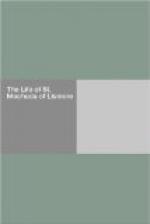The Life presents considerable evidence of historical reliability; its geography is detailed and correct; its references to contemporaries of Mochuda are accurate on the whole and there are few inconsistencies or none. Moreover it sheds some new light on that chronic puzzle— organisation of the Celtic Church of Ireland. Mochuda, head of a great monastery at Rahen, is likewise a kind of pluralist Parish Priest with a parish in Kerry, administered in his name by deputed ecclesiastics, and other parishes similarly administered in Kerrycurrihy, Rostellan, West Muskerry, and Spike Island, Co. Cork. When a chief parishioner lies seriously ill in distant Corca Duibhne, Mochuda himself comes all the way from the centre of Ireland to administer the last rites to the dying man, and so on.
The relations of the people to the Church and its ministers are in many respects not at all easy to understand. Oblations, for instance, of themselves and their territory, &c., by chieftains are frequent. Oblations of monasteries are made in a similar way. Probably this signifies no more than that the chief region or monastery put itself under the saint’s jurisdiction or rule or both. That there were other churches too than the purely monastic appears from offerings to Mochuda of already existing churches, v.g. from the Clanna Ruadhan in Decies, &c.
Lismore, the most famous of Mochuda’s foundations, became within a century of the saint’s death, one of the great monastic schools of Erin, attracting to his halls, or rather to its boothies, students from all Ireland and even—so it is claimed—from lands beyond the seas. King Alfrid [Aldfrith] of Northumbria, for instance, is said to have partaken of Lismore’s hospitality, and certainly Cormac of Cashel, Malachy and Celsus of Armagh and many others of the most distinguished of the Scots partook thereof. The roll of Lismore’s calendared saints would require, did the matter fall within our immediate province, more than one page to itself. Some interesting reference to Mochuda and his holy city occur in the Life of one of his disciples, St. Colman Maic Luachain, edited for the R.I.A. by Professor Kuno Meyer.




